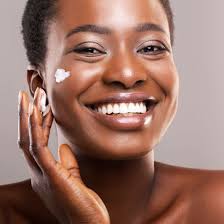Eczema Treatment for Dark Skin: Tailored Care for Melanin-Rich Skin Tones
Eczema doesn’t look the same on everyone—and treating it shouldn’t either. For those with dark or melanin-rich skin, eczema can appear differently, heal differently, and require a more specialized approach to avoid long-term effects like hyperpigmentation or scarring.

This post explores the nuances of eczema treatment for dark skin, offering research-backed tips on diagnosis, therapy, and post-flare care that supports both skin health and tone preservation.
How Eczema Presents in Dark Skin
Eczema often goes underdiagnosed or misdiagnosed in darker skin tones because the classic signs—redness, inflammation, and scaling—don’t always look the same. Check out this NIH article for more information.
In skin types IV–VI (Fitzpatrick scale), eczema may present as:
- Grey, purplish, or dark brown patches instead of red
- Dry, rough, or scaly skin that feels thickened (lichenification)
- Prominent follicular eczema (tiny bumps clustered around hair follicles)
- Post-inflammatory hyperpigmentation or hypopigmentation after healing
Evidence: A study in Pediatric Dermatology found that 65% of children with darker skin tones were misdiagnosed with other conditions before receiving an accurate eczema diagnosis.
Recognizing these differences is essential for choosing the right treatments and preventing pigment changes.
Treatment Priorities for Darker Skin Tones
1. Reduce Inflammation Without Over-Drying
Overly aggressive treatments (e.g., high-potency steroids or harsh soaps) can cause excess dryness, which may worsen hyperpigmentation or cause skin peeling.
Recommended steps:
- Use low- to mid-potency steroids only when prescribed, and only for short periods
- Prefer non-steroidal anti-inflammatory creams (like tacrolimus or pimecrolimus) on sensitive areas like the face or neck
- Moisturize 2–3x daily to prevent transepidermal water loss
2. Restore Barrier Function with Targeted Moisturizers
Melanin-rich skin is more prone to ashy appearance when dry. Rich emollients that restore ceramides and trap hydration are vital.
Look for:
- Ceramides + cholesterol to rebuild the lipid matrix
- Colloidal oatmeal or panthenol for anti-inflammatory effects
- Urea or lactic acid in small amounts (≤10%) for gentle exfoliation and moisture retention
3. Prevent and Manage Hyperpigmentation
Post-inflammatory hyperpigmentation (PIH) is not a sign of active eczema, but a visible legacy of inflammation—especially common in darker skin. Left untreated, it can linger for months.
Tips to prevent PIH:
- Treat flares early with soothing balms and anti-inflammatory creams
- Avoid scratching—this worsens pigmentary changes
- Use mineral sunscreens (SPF 30+) to protect healing areas
To fade existing marks:
- Use niacinamide or azelaic acid (gentle brighteners safe for eczema-prone skin)
- Avoid harsh lightening agents like hydroquinone unless supervised by a dermatologist
4. Adapt Treatment to Cultural Practices and Haircare
For many with melanin-rich skin, haircare practices (e.g., oils, gels, relaxers) and cultural cleansing routines can affect eczema.
- Use fragrance-free shampoos and keep hair products away from eczema-affected areas
- Avoid alcohol-based styling products that can run down onto facial or neck eczema
- If using oils (e.g., coconut or castor), test small areas first—these can clog pores or worsen flares if applied over active lesions
Product and Lifestyle Integration
Daily habits make a difference:
- Wear loose, breathable fabrics (cotton, bamboo)
- Moisturize immediately after bathing (reference our article on the best moisturizers)
- Use lukewarm water only
- Avoid overly aggressive exfoliation (loofahs, scrubs)
Final Thoughts
Eczema treatment for dark skin isn’t one-size-fits-all. It requires a sensitive, informed approach that considers not just inflammation but also post-flare skin tone changes, common misdiagnoses, and unique hydration needs.
With the right combination of barrier-supporting moisturizers, anti-inflammatory treatments, and gentle brighteners, individuals with melanin-rich skin can control eczema while preserving tone, texture, and confidence.
Research Highlights: Understanding Eczema in Diverse Skin Types
A 2023 article in JAMA Dermatology stressed that medical education often lacks visual training in diagnosing eczema in darker skin tones. The study called for more inclusive dermatology curricula and emphasized that early intervention reduces PIH risk and improves outcomes for patients of colour.
Meanwhile, a 2021 double-blind trial at Howard University Hospital found that a ceramide-based cream paired with niacinamide significantly reduced eczema symptoms and PIH in Black women compared to a placebo.
Davis, E. et al. (2023). Addressing Diagnostic Bias in Atopic Dermatitis: Implications for Patients With Skin of Color. JAMA Dermatology, 159(2), 145–151. https://doi.org/10.1001/jamadermatol.2022.4552
Our Promise to You
We’re confident our products will transform your skin—but if you’re not completely satisfied, we’ve got your back. Simple as that. Try our products risk-free for 30 days. If you don’t love your results, reach out to our care team and we’ll make it right with a full refund. No questions asked, no complicated returns process. Because everyone deserves skincare that works.

